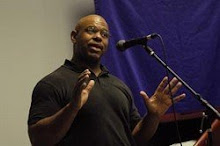As I'm working through the Book of Revelation for my sermon series, I remembered and tracked down this scene from the old
Good Times television show. Consistent with his aspects of his character on the show, the young man who played Michael Evans attended a church in Brooklyn, NY whose pastor taught that Jesus was Black largely based on the vision found in Revelation 1, especially verse 14. I heard that pastor speak on different occasions when I was a young man growing up in New York (I am about the same age as the actor who played Michael).
The image of a Black Jesus is scandalous to many. Of course, I do not believe that good exegesis of the vision in Revelation 1 leads us to conclude anything about the nationality, ethnicity, or race of Jesus. But certainly the other picture of Jesus that was hanging on the wall in the video clip -- the common one of blonde, blue-eyed Jesus -- needs to be criticized and viewed as scandalous as well. That traditional picture does not help when it comes to historicity, and it certainly is not a helpful picture when it comes to theology or mission.
Theologian James Cone wrote this several years ago:
To suggest that Christ has taken on a black skin is not a theological emotionalism.
If the church is a continuation of the Incarnation, and if the Church and Christ are
where the oppressed are free, then Christ and his Church must identify totally with
the oppressed to the extent that they too suffer for the same reasons persons are
enslaved. In America, blacks are oppressed because of their blackness. It would seem
then, that emancipation could only be realized by Christ and his Church becoming
black. Thinking of Christ as nonblack in the twentieth century is as theologically
impossible as thinking of him as non-Jewish in the first century.
(James R. Cone, "The White Church and Black Power" in Black Theology: A Documentary History; Vol 1: 1966-1979; pp. 70-71)
While we may not agree with Cone on all his theological views, he offers us a good challenge. The point is that Jesus identifies with oppressed people. And isn't that happening in Revelation? The vision in Revelation 1 is of the Lord among the lampstands, i.e., among his churches (Rev 1:20). He is right in the midst of his people! The letters to the 7 churches found in chapters 2 & 3 of Revelation depict a Lord who identifies with people who face great tribulation and are the objects of oppression. The historical Jesus may not have been African American, but from what we know of his teachings, the darker-skinned people of the world -- many of whom have faced and still face oppression -- can find a Savior who relates to them and maybe even looks more like them than do their oppressors.
